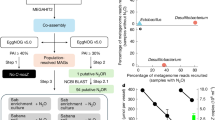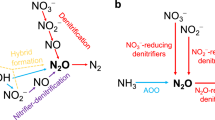Abstract
Nitrous oxide (N2O) is a major radiative forcing and stratospheric ozone-depleting gas emitted from terrestrial and aquatic ecosystems. It can be transformed to nitrogen gas (N2) by bacteria and archaea harboring the N2O reductase (N2OR), which is the only known N2O sink in the biosphere. Despite its crucial role in mitigating N2O emissions, knowledge of the N2OR in the environment remains limited. Here, we report a comprehensive phylogenetic analysis of the nosZ gene coding the N2OR in genomes retrieved from public databases. The resulting phylogeny revealed two distinct clades of nosZ, with one unaccounted for in studies investigating N2O-reducing communities. Examination of N2OR structural elements not considered in the phylogeny revealed that the two clades differ in their signal peptides, indicating differences in the translocation pathway of the N2OR across the membrane. Sequencing of environmental clones of the previously undetected nosZ lineage in various environments showed that it is widespread and diverse. Using quantitative PCR, we demonstrate that this clade was most often at least as abundant as the other, thereby more than doubling the known extent of the overall N2O-reducing community in the environment. Furthermore, we observed that the relative abundance of nosZ from either clade varied among habitat types and environmental conditions. Our results indicate a physiological dichotomy in the diversity of N2O-reducing microorganisms, which might be of importance for understanding the relationship between the diversity of N2O-reducing microorganisms and N2O reduction in different ecosystems.
Similar content being viewed by others
Log in or create a free account to read this content
Gain free access to this article, as well as selected content from this journal and more on nature.com
or
Accession codes
References
Abascal F, Zardoya R, Posada D . (2005). ProtTest: selection of best-fit models of protein evolution. Bioinformatics 21: 2104–2105.
Avrahami S, Bohannan BJM . (2009). N2O emission rates in a California meadow soil are influenced by fertilizer level, soil moisture and the community structure of ammonia-oxidizing bacteria. Global Change Biol 15: 643–655.
Babić KH, Schauss K, Hai B, Sikora S, Redzepović S, Radl V et al (2008). Influence of different Sinorhizobium meliloti inocula on abundance of genes involved in nitrogen transformations in the rhizosphere of alfalfa (Medicago sativa L.). Environ Microbiol 10: 2922–2930.
Bagos PG, Nikolaou EP, Liakopoulos TD, Tsirigos KD . (2010). Combined prediction of Tat and Sec signal peptides with hidden Markov models. Bioinformatics 26: 2811–2817.
Bru D, Ramette A, Saby NPA, Dequiedt S, Ranjard L, Jolivet C et al (2010). Determinants of the distribution of nitrogen-cycling microbial communities at the landscape scale. ISME J 5: 532–542.
Cavigelli M, Robertson G . (2000). The functional significance of denitrifier community composition in a terrestrial ecosystem. Ecology 81: 1402–1414.
Chapuis-Lardy L, Wrage N, Metay A, Chotte J, Bernoux M . (2007). Soils, a sink for N2O? A review. Global Change Biol 13: 1–17.
Cheneby D, Perrez S, Devroe C, Hallet S, Couton Y, Bizouard F et al (2004). Denitrifying bacteria in bulk and maize-rhizospheric soil: diversity and N 2 O-reducing abilities. Can J Microbiol 50: 469–474.
Eddy S . (1998). Profile hidden Markov models. Bioinformatics 14: 755–763.
Fierer N, Bradford MA, Jackson RB . (2007). Toward an ecological classification of soil bacteria. Ecology 88: 1354–1364.
Garcia-Lledo A, Vilar-Sanz A, Trias R, Hallin S, Baneras L . (2011). Genetic potential for N2O emissions from the sediment of a free water surface constructed wetland. Water Res 45: 5621–5632.
Green SJ, Prakash O, Gihring TM, Akob DM, Jasrotia P, Jardine PM et al (2010). Denitrifying bacteria isolated from terrestrial subsurface sediments exposed to mixed-waste contamination. Appl Environ Microb 76: 3244–3254.
Hallin S, Jones CM, Schloter M, Philippot L . (2009). Relationship between N-cycling communities and ecosystem functioning in a 50-year-old fertilization experiment. ISME J 3: 597–605.
Henry S, Bru D, Stres B, Hallet S, Philippot L . (2006). Quantitative detection of the nosZ gene, encoding nitrous oxide reductase, and comparison of the abundances of 16S rRNA, narG, nirK, and nosZ genes in soils. Appl Environ Microb 72: 5181–5189.
Huber T, Faulkner G, Hugenholtz P . (2004). Bellerophon: a program to detect chimeric sequences in multiple sequence alignments. Bioinformatics 20: 2317–2319.
Hugenholtz P, Stackebrandt E . (2004). Reclassification of Sphaerobacter thermophilus from the subclass Sphaerobacteridae in the phylum Actinobacteria to the class Thermomicrobia (emended description) in the phylum Chloroflexi (emended description). Int J Syst Evol Micr 54: 2049–2051.
Jones CM, Stres B, Rosenquist M, Hallin S . (2008). Phylogenetic analysis of nitrite, nitric oxide, and nitrous oxide respiratory enzymes reveal a complex evolutionary history for denitrification. Mol Biol Evol 25: 1955–1966.
Jones CM, Welsh A, Throbäck IN, Dorsch P, Bakken LR, Hallin S . (2011). Phenotypic and genotypic heterogeneity among closely related soil-borne N2—and N2O-producing Bacillus isolates harboring the nosZ gene. Fems Microbiol Ecol 76: 541–552.
Kandeler E, Deiglmayr K, Tscherko D, Bru D, Philippot L . (2006). Abundance of narG, nirS, nirK, and nosZ genes of denitrifying bacteria during primary successions of a glacier foreland. Appl Environ Microb 72: 5957–5962.
Katoh K, Toh H . (2008). Recent developments in the MAFFT multiple sequence alignment program. Brief Bioinform 9: 286–298.
Kirchman DL, Cottrell MT, Lovejoy C . (2010). The structure of bacterial communities in the western Arctic Ocean as revealed by pyrosequencing of 16S rRNA genes. Environ Microbiol 12: 1132–1143.
Lauber C, Hamady M, Knight R . (2009). Pyrosequencing-based assessment of soil pH as a predictor of soil bacterial community structure at the continental scale. Appl Environ Microb 75: 5111–5120.
Le SQ, Gascuel O . (2008). An improved general amino acid replacement matrix. Mol Biol Evol 25: 1307–1320.
Lee PA, Tullman-Ercek D, Georgiou G . (2006). The bacterial twin-arginine translocation pathway. Annu Rev Microbiol 60: 373–395.
Lopez-Gutierrez J, Henry S, Hallet S, Martin-Laurent F, Catroux G, Philippot L . (2004). Quantification of a novel group of nitrate-reducing bacteria in the environment by real-time PCR. J Microbiol Meth 57: 399–407.
Ludwig W, Strunk O, Westram R, Richter L, Meier H, Yadhukumar et al (2004). ARB: a software environment for sequence data. Nucleic Acids Res 32: 1363–1371.
McGuffin L, Bryson K, Jones D . (2000). The PSIPRED protein structure prediction server. Bioinformatics 16: 404–405.
Mosier AR . (1998). Soil processes and global change. Biol Fert Soils 27: 221–229.
Newton RJ, Jones SE, Eiler A, McMahon KD, Bertilsson S . (2011). A guide to the natural history of freshwater lake bacteria. Microbiol Mol Biol Rev 75: 14–49.
Palmer K, Drake HL, Horn MA . (2009). Genome-derived criteria for assigning environmental narG and nosZ sequences to operational taxonomic units of nitrate reducers. Appl Environ Microb 75: 5170–5174.
Petersen DG, Blazewicz SJ, Firestone M, Herman DJ, Turetsky M, Waldrop M . (2012). Abundance of microbial genes associated with nitrogen cycling as indices of biogeochemical process rates across a vegetation gradient in Alaska. Environ Microbiol 14: 993–1008.
Philippot L, Abbate C, Bispo A, Chesnot T, Hallin S, Lemanceau P et al (2010). Soil microbial diversity: an ISO standard for soil DNA extraction. J Soil Sediment 10: 1344–1345.
Philippot L, Andert J, Jones CM, Bru D, Hallin S . (2011). Importance of denitrifiers lacking the genes encoding the nitrous oxide reductase for N2O emissions from soil. Global Change Biol 17: 1497–1504.
Philippot L, Cuhel J, Saby NPA, Cheneby D, Chronakova A, Bru D et al (2009a). Mapping field-scale spatial patterns of size and activity of the denitrifier community. Environ Microbiol 11: 1518–1526.
Philippot L, Hallin S, Borjesson G, Baggs EM . (2009b). Biochemical cycling in the rhizosphere having an impact on global change. Plant Soil 321: 61–81.
Pohlschröder M, Hartmann E, Hand NJ, Dilks K, Haddad A . (2005). Diversity and evolution of protein translocation. Annu Rev Microbiol 59: 91–111.
Pomowski A, Zumft WG, Kroneck PMH, Einsle O . (2011). N2O binding at a [4Cu:2S] copper-sulphur cluster in nitrous oxide reductase. Nature 477: 234–237.
Ravishankara AR, Daniel JS, Portmann RW . (2009). Nitrous oxide (N2O): the dominant ozone-depleting substance emitted in the 21st century. Science 326: 123–125.
Richardson D, Felgate H, Watmough N, Thomson A, Baggs E . (2009). Mitigating release of the potent greenhouse gas N2O from the nitrogen cycle—could enzymic regulation hold the key? Trends Biotechnol 27: 388–397.
Roesch LF, Fulthorpe RR, Riva A, Casella G, Hadwin AKM, Kent AD et al (2007). Pyrosequencing enumerates and contrasts soil microbial diversity. ISME J 1: 283–290.
Rose T, Schultz E, Henikoff J, Pietrokovski S, McCallum C, Henikoff S . (1998). Consensus-degenerate hybrid oligonucleotide primers for amplification of distantly related sequences. Nucleic Acids Res 26: 1628–1635.
Sanford R, Cole J, Tiedje J . (2002). Characterization and description of Anaeromyxobacter dehalogenans gen. nov., sp nov., an aryl-halorespiring facultative anaerobic myxobacterium. Appl Environ Microb 68: 893–900.
Simon J, Einsle O, Kroneck PMH, Zumft WG . (2004). The unprecedented nos gene cluster of Wolinella succinogenes encodes a novel respiratory electron transfer pathway to cytochrome c nitrous oxide reductase. FEBS Lett 569: 7–12.
Spain AM, Krumholz LR, Elshahed MS . (2009). Abundance, composition, diversity and novelty of soil Proteobacteria. ISME J 3: 992–1000.
Stamatakis A . (2006). RAxML-VI-HPC: maximum likelihood-based phylogenetic analyses with thousands of taxa and mixed models. Bioinformatics 22: 2688–2690.
Van Spanning RJM . (2011). Structure, function, regulation and evolution of the nitrite and nitrous oxide reductases: denitrification enzymes with a beta-propeller Fold. In: Moir JWB, (ed) Nitrogen Cycling in Bacteria: Molecular Analysis. Calister Academic Press: Norwich UK, pp 135–161.
Wessén E, Hallin S, Philippot L . (2010). Differential responses of bacterial and archaeal groups at high taxonomical ranks to soil management. Soil Biol Biochem 42: 1759–1765.
Wood D, Setubal J, Kaul R, Monks D, Kitajima J, Okura V et al (2001). The genome of the natural genetic engineer Agrobacterium tumefaciens C58. Science 294: 2317–2323.
Yergeau E, Kowalchuk GA . (2008). Responses of Antarctic soil microbial communities and associated functions to temperature and freeze-thaw cycle frequency. Environ Microbiol 10: 2223–2235.
Youssef NH, Elshahed MS . (2009). Diversity rankings among bacterial lineages in soil. ISME J 3: 305–313.
Zumft WG . (1997). Cell biology and molecular basis of denitrification. Microbiol Mol Biol Rev 61: 533–616.
Zumft W, Bothe H . (2007). Nitrous oxide reductases. In: Bothe H, Ferguson SJ, Newton WE, (eds) Biology of the Nitrogen Cycle. Elsevier: Amsterdam, pp 67–81.
Zumft W, Kroneck P . (2007). Respiratory transformation of nitrous oxide (N2O) to dinitrogen by Bacteria and Archaea. Adv Microb Physiol 52: 107–227.
Acknowledgements
We gratefully acknowledge K McMahon, E Pelve and R Bernander for providing genomic DNA from Candidatus accumulibacter, Haloarcula marismortui and Pyrobaculum calidifontidis, J Andert for the Magnetospirillum magneticum culture and A Welsh for technical assistance. This work was supported by the European Commission within EcoFINDERS project (FP7-264465), the Swedish Research Council Formas (contract 2007-1197) and the Oscar and Lili Lamm foundation (2010-11-13).
Author information
Authors and Affiliations
Corresponding author
Additional information
Supplementary Information accompanies the paper on The ISME Journal website
Supplementary information
Rights and permissions
About this article
Cite this article
Jones, C., Graf, D., Bru, D. et al. The unaccounted yet abundant nitrous oxide-reducing microbial community: a potential nitrous oxide sink. ISME J 7, 417–426 (2013). https://doi.org/10.1038/ismej.2012.125
Received:
Revised:
Accepted:
Published:
Issue date:
DOI: https://doi.org/10.1038/ismej.2012.125
Keywords
This article is cited by
-
Salinity decouples the relationships between microbial functional gene abundance and N2O emissions in subtropical agricultural soils
Journal of Soils and Sediments (2024)
-
Sugarcane cultivation altered soil nitrogen cycling microbial processes and decreased nitrogen bioavailability in tropical Australia
Journal of Soils and Sediments (2024)
-
Nitrogen transformation processes catalyzed by manure microbiomes in earthen pit and concrete storages on commercial dairy farms
Environmental Microbiome (2023)
-
Potential relevance between soybean nitrogen uptake and rhizosphere prokaryotic communities under waterlogging stress
ISME Communications (2023)
-
Enrichment and characterization of a nitric oxide-reducing microbial community in a continuous bioreactor
Nature Microbiology (2023)



